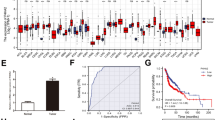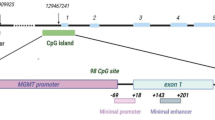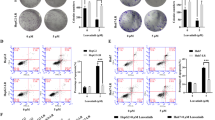Abstract
Nasopharyngeal carcinoma (NPC) is a rare but highly invasive cancer that is prevalent among people of southern Chinese ancestry in southern China and Southeast Asia. Radiotherapy and cisplatin (CDDP)-based chemotherapy are the main treatment options. Unfortunately, disease response to concurrent chemoradiotherapy varies among patients with NPC, and many cases are resistant to CDDP and radiotherapy. NFBD1 functions in cell cycle checkpoint activation and DNA repair following DNA damage. In this study, we identified the NFBD1 as a tractable molecular target to chemosensitize NPC cells. NFBD1 expression in NPC CNE1 cell lines was depleted using lentivirus-mediated short hairpin RNA, and the elevated sensitivity of these NFBD1-inhibited NPC cells to therapeutic reagent CDDP and 5-fluorouracil (5-FU) was evaluated using MTS assays. Flow cytometry analysis also showed that NFBD1 knockdown led to an obvious induction of apoptosis in CDDP- or 5-FU-treated CNE1 cells. Furthermore, we implicated the involvement of NFBD1 in Rad51 and DNA-PKcs foci formation following CDDP or 5-FU chemotherapy. In conclusion, NFBD1 knockdown improves the chemosensitivity of NPC cells by inhibiting cell growth and promoting apoptosis through the impairment of DNA damage repair, suggesting NFBD1 as a novel therapeutic target for NPC.





Similar content being viewed by others
References
Wei WI, Sham JS (2005) Nasopharyngeal carcinoma. Lancet 365:2041–2054. doi:10.1016/s0140-6736(05)66698-6
Chen W, Zheng R, Baade PD, Zhang S, Zeng H, Bray F, Jemal A, Yu XQ, He J (2016) Cancer statistics in China, 2015. CA Cancer J Clin. doi:10.3322/caac.21338
Lo KW, To KF, Huang DP (2004) Focus on nasopharyngeal carcinoma. Cancer Cell 5:423–428
Lo KW, Chung GT, To KF (2012) Deciphering the molecular genetic basis of NPC through molecular, cytogenetic, and epigenetic approaches. Semin Cancer Biol 22:79–86. doi:10.1016/j.semcancer.2011.12.011
Bensouda Y, Kaikani W, Ahbeddou N, Rahhali R, Jabri M, Mrabti H, Boussen H, Errihani H (2011) Treatment for metastatic nasopharyngeal carcinoma. Eur Ann Otorhinolaryngol Head Neck Dis 128:79–85. doi:10.1016/j.anorl.2010.10.003
Lee AW, Poon YF, Foo W, Law SC, Cheung FK, Chan DK, Tung SY, Thaw M, Ho JH (1992) Retrospective analysis of 5037 patients with nasopharyngeal carcinoma treated during 1976–1985: overall survival and patterns of failure. Int J Radiat Oncol Biol Phys 23:261–270
Ando K, Ozaki T, Hirota T, Nakagawara A (2013) NFBD1/MDC1 is phosphorylated by PLK1 and controls G2/M transition through the regulation of a TOPOIIalpha-mediated decatenation checkpoint. PLoS ONE 8:e82744. doi:10.1371/journal.pone.0082744
Goldberg M, Stucki M, Falck J, D’Amours D, Rahman D, Pappin D, Bartek J, Jackson SP (2003) MDC1 is required for the intra-S-phase DNA damage checkpoint. Nature 421:952–956
Lou Z, Minter-Dykhouse K, Wu X, Chen J (2003) MDC1 is coupled to activated CHK2 in mammalian DNA damage response pathways. Nature 421:957–961. doi:10.1038/nature01447
Stewart GS, Wang B, Bignell CR, Taylor AMR, Elledge SJ (2003) MDC1 is a mediator of the mammalian DNA damage checkpoint. Nature 421:961–966
Eliezer Y, Argaman L, Kornowski M, Roniger M, Goldberg M (2014) Interplay between the DNA damage proteins MDC1 and ATM in the regulation of the spindle assembly checkpoint. J Biol Chem 289:8182–8193. doi:10.1074/jbc.M113.532739
Ozaki T, Nagase T, Ichimiya S, Seki N, Ohiri M, Nomura N, Takada N, Sakiyama S, Weber BL, Nakagawara A (2000) NFBD1/KIAA0170 is a novel nuclear transcriptional transactivator with BRCT domain. DNA Cell Biol 19:475–485
Rogakou EP, Boon C, Redon C, Bonner WM (1999) Megabase chromatin domains involved in DNA double-strand breaks in vivo. J Cell Biol 146:905–916
Carlessi L, Fusar Poli E, Bechi G, Mantegazza M, Pascucci B, Narciso L, Dogliotti E, Sala C, Verpelli C, Lecis D, Delia D (2014) Functional and molecular defects of hiPSC-derived neurons from patients with ATM deficiency. Cell Death Dis 5:e1342. doi:10.1038/cddis.2014.310
Banath JP, Klokov D, MacPhail SH, Banuelos CA, Olive PL (2010) Residual gammaH2AX foci as an indication of lethal DNA lesions. BMC Cancer 10:4. doi:10.1186/1471-2407-10-4
Rogakou EP, Pilch DR, Orr AH, Ivanova VS, Bonner WM (1998) DNA double-stranded breaks induce histone H2AX phosphorylation on serine 139. J Biol Chem 273:5858–5868
Mah LJ, El-Osta A, Karagiannis TC (2010) gammaH2AX: a sensitive molecular marker of DNA damage and repair. Leukemia 24:679–686. doi:10.1038/leu.2010.6
Chang L, Graham PH, Hao J, Ni J, Bucci J, Cozzi PJ, Kearsley JH, Li Y (2014) PI3 K/Akt/mTOR pathway inhibitors enhance radiosensitivity in radioresistant prostate cancer cells through inducing apoptosis, reducing autophagy, suppressing NHEJ and HR repair pathways. Cell Death Dis 5:e1437. doi:10.1038/cddis.2014.415
Kanaar R, Hoeijmakers JH, van Gent DC (1998) Molecular mechanisms of DNA double strand break repair. Trends Cell Biol 8:483–489
Johnson R, Jasin M (2001) Double-strand-break-induced homologous recombination in mammalian cells. Biochem Soc Trans 29:196–200
Löbrich M, Jeggo PA (2005) The two edges of the ATM sword: co-operation between repair and checkpoint functions. Radiother Oncol 76:112–118
O’Driscoll M, Jeggo PA (2006) The role of double-strand break repair—insights from human genetics. Nat Rev Genet 7:45–54
Löbrich M, Jeggo PA (2005) Harmonising the response to DSBs: a new string in the ATM bow. DNA Repair 4:749–759
Thompson LH, Schild D (2001) Homologous recombinational repair of DNA ensures mammalian chromosome stability. Mutat Res/Fundam Mol Mech Mutagen 477:131–153
Shima H, Suzuki H, Sun J, Kono K, Shi L, Kinomura A, Horikoshi Y, Ikura T, Ikura M, Kanaar R (2013) Activation of the SUMO modification system is required for the accumulation of RAD51 at sites of DNA damage. J Cell Sci 126:5284–5292
Wang Z, Zeng Q, Chen T, Liao K, Bu Y, Hong S, Hu G (2015) Silencing NFBD1/MDC1 enhances the radiosensitivity of human nasopharyngeal cancer CNE1 cells and results in tumor growth inhibition. Cell Death Dis 6:e1849. doi:10.1038/cddis.2015.214
Matuo R, Sousa FG, Escargueil AE, Grivicich I, Garcia-Santos D, Chies JA, Saffi J, Larsen AK, Henriques JA (2009) 5-Fluorouracil and its active metabolite FdUMP cause DNA damage in human SW620 colon adenocarcinoma cell line. J Appl Toxicol 29:308–316. doi:10.1002/jat.1411
Matuo R, Sousa FG, Escargueil AE, Soares DG, Grivicich I, Saffi J, Larsen AK, Henriques JA (2010) DNA repair pathways involved in repair of lesions induced by 5-fluorouracil and its active metabolite FdUMP. Biochem Pharmacol 79:147–153. doi:10.1016/j.bcp.2009.08.016
Wyatt MD, Wilson DM 3rd (2009) Participation of DNA repair in the response to 5-fluorouracil. Cell Mol Life Sci 66:788–799. doi:10.1007/s00018-008-8557-5
Lin ZP, Lee Y, Lin F, Belcourt MF, Li P, Cory JG, Glazer PM, Sartorelli AC (2011) Reduced level of ribonucleotide reductase R2 subunits increases dependence on homologous recombination repair of cisplatin-induced DNA damage. Mol Pharmacol 80:1000–1012. doi:10.1124/mol.111.074708
Hui EP, Ma BB, Leung SF, King AD, Mo F, Kam MK, Yu BK, Chiu SK, Kwan WH, Ho R, Chan I, Ahuja AT, Zee BC, Chan AT (2009) Randomized phase II trial of concurrent cisplatin-radiotherapy with or without neoadjuvant docetaxel and cisplatin in advanced nasopharyngeal carcinoma. J Clin Oncol 27:242–249. doi:10.1200/jco.2008.18.1545
Chan AT (2010) Nasopharyngeal carcinoma. Ann Oncol 21(Suppl 7):308–312. doi:10.1093/annonc/mdq277
Bensouda Y, Kaikani W, Ahbeddou N, Rahhali R, Jabri M, Mrabti H, Boussen H, Errihani H (2011) Treatment for metastatic nasopharyngeal carcinoma. Eur Ann Otorhinolaryngol Head Neck Dis 128:79–85. doi:10.1016/j.anorl.2010.10.003
Ginn SL, Alexander IE, Edelstein ML, Abedi MR, Wixon J (2013) Gene therapy clinical trials worldwide to 2012—an update. J Gene Med 15:65–77. doi:10.1002/jgm.2698
Cesani M, Plati T, Lorioli L, Benedicenti F, Redaelli D, Dionisio F, Biasco L, Montini E, Naldini L, Biffi A (2015) Shedding of clinical-grade lentiviral vectors is not detected in a gene therapy setting. Gene Ther 22:496–502. doi:10.1038/gt.2015.10
Kastan MB, Bartek J (2004) Cell-cycle checkpoints and cancer. Nature 432:316–323
Bartek J, Lukas J (2007) DNA damage checkpoints: from initiation to recovery or adaptation. Curr Opin Cell Biol 19:238–245. doi:10.1016/j.ceb.2007.02.009
Burma S, Chen BP, Murphy M, Kurimasa A, Chen DJ (2001) ATM phosphorylates histone H2AX in response to DNA double-strand breaks. J Biol Chem 276:42462–42467
Nakanishi M, Ozaki T, Yamamoto H, Hanamoto T, Kikuchi H, Furuya K, Asaka M, Delia D, Nakagawara A (2007) NFBD1/MDC1 associates with p53 and regulates its function at the crossroad between cell survival and death in response to DNA damage. J Biol Chem 282:22993–23004
Vousden KH, Prives C (2009) Blinded by the light: the growing complexity of p53. Cell 137:413–431. doi:10.1016/j.cell.2009.04.037
Bieging KT, Mello SS, Attardi LD (2014) Unravelling mechanisms of p53-mediated tumour suppression. Nat Rev Cancer 14:359–370
Sullivan KD, Gallant-Behm CL, Henry RE, Fraikin JL, Espinosa JM (2012) The p53 circuit board. Biochim Biophys Acta (BBA) Rev Cancer 1825:229–244
Kluck RM, Bossy-Wetzel E, Green DR, Newmeyer DD (1997) The release of cytochrome c from mitochondria: a primary site for Bcl-2 regulation of apoptosis. Science 275:1132–1136
Lou Z, Minter-Dykhouse K, Franco S, Gostissa M, Rivera MA, Celeste A, Manis JP, van Deursen J, Nussenzweig A, Paull TT (2006) MDC1 maintains genomic stability by participating in the amplification of ATM-dependent DNA damage signals. Mol Cell 21:187–200
Mailand N, Bekker-Jensen S, Faustrup H, Melander F, Bartek J, Lukas C, Lukas J (2007) RNF8 ubiquitylates histones at DNA double-strand breaks and promotes assembly of repair proteins. Cell 131:887–900. doi:10.1016/j.cell.2007.09.040
Kinner A, Wu W, Staudt C, Iliakis G (2008) Gamma-H2AX in recognition and signaling of DNA double-strand breaks in the context of chromatin. Nucleic Acids Res 36:5678–5694. doi:10.1093/nar/gkn550
Weaver DT (1995) What to do at an end: DNA double-strand-break repair. Trends Genet 11:388–392
Liang F, Han M, Romanienko PJ, Jasin M (1998) Homology-directed repair is a major double-strand break repair pathway in mammalian cells. Proc Natl Acad Sci USA 95:5172–5177
Takata M, Sasaki MS, Sonoda E, Morrison C, Hashimoto M, Utsumi H, Yamaguchi-Iwai Y, Shinohara A, Takeda S (1998) Homologous recombination and non-homologous end-joining pathways of DNA double-strand break repair have overlapping roles in the maintenance of chromosomal integrity in vertebrate cells. EMBO J 17:5497–5508. doi:10.1093/emboj/17.18.5497
Kashishian A, Douangpanya H, Clark D, Schlachter ST, Eary CT, Schiro JG, Huang H, Burgess LE, Kesicki EA, Halbrook J (2003) DNA-dependent protein kinase inhibitors as drug candidates for the treatment of cancer. Mol Cancer Ther 2:1257–1264
Daboussi F, Dumay A, Delacôte F, Lopez BS (2002) DNA double-strand break repair signalling: the case of RAD51 post-translational regulation. Cell Signal 14:969–975
Chan DW, Chen BP-C, Prithivirajsingh S, Kurimasa A, Story MD, Qin J, Chen DJ (2002) Autophosphorylation of the DNA-dependent protein kinase catalytic subunit is required for rejoining of DNA double-strand breaks. Genes Dev 16:2333–2338
Bucher N, Britten CD (2008) G2 checkpoint abrogation and checkpoint kinase-1 targeting in the treatment of cancer. Br J Cancer 98:523–528. doi:10.1038/sj.bjc.6604208
Schmidt M, Bastians H (2007) Mitotic drug targets and the development of novel anti-mitotic anticancer drugs. Drug Resist Updates 10:162–181. doi:10.1016/j.drup.2007.06.003
Acknowledgments
This work was supported by the Health Bureau of Chongqing (2013-2-013), the National Natural Science Foundation of China (No. 81470676 and 81271061) and the National Key Clinical Specialties Construction Program of China.
Author information
Authors and Affiliations
Corresponding author
Rights and permissions
About this article
Cite this article
Zeng, Q., Wang, Z., Liu, C. et al. Knockdown of NFBD1/MDC1 enhances chemosensitivity to cisplatin or 5-fluorouracil in nasopharyngeal carcinoma CNE1 cells. Mol Cell Biochem 418, 137–146 (2016). https://doi.org/10.1007/s11010-016-2739-5
Received:
Accepted:
Published:
Issue Date:
DOI: https://doi.org/10.1007/s11010-016-2739-5




